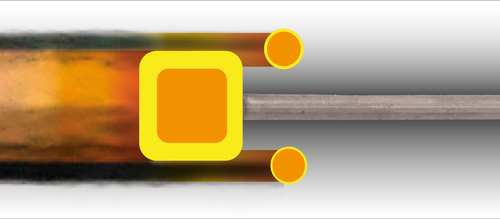
Cladding with diode lasers
Cladding with lasers, also called laser metal deposition, has already a long tradition. And today, the meaning of the application has continued to increase due to permanent material and never-ending technological innovation. No surprising then that in the last two decades or so, cladding with lasers has become one of the most important applications for diode lasers — reason enough therefore to take a closer look at this method in our mini-series “diode lasers and their applications”.
Part 3: The Cladding Process
With laser cladding, the laser beam creates a molten pool on the surface of the workpiece, to which the coating material (powder or wire) is added and at the same time melted by the laser. The process result is an additional layer on the component surface that is metallurgically connected with the basic material.
Advantages
The metallurgical connection is far more stable than the mechanical grouting created at thermal spraying, for example. Short exposure times and low exposure depths only cause very little warpage; hence, a rather rapid cooling. An absolute plus is the homogeneous intensity distribution in the diode laser beam (top hat profile). During the welding process, the beam profile of the diode laser creates a very even molten pool, which then again generates a pore-free and crack-free surface condition. Because of the high surface quality, post-processing is hardly necessary.
Today, components that were refined by means of laser cladding can be found almost everywhere. They are used inter alia in heavy industry, vehicle production or agriculture. This wide range of applications is due to the high flexibility of laser technology. However, the motivations for applying an additional material can vary greatly. A wear protection can be realized with the help of diode lasers that are as reliable as an anticorrosive layer or the repair of a worn component. Depending on the application process, variations are possible that especially influence the selection of the coating material.
Motivation corrosion protection
Laser cladding can prevent both creep corrosion and crevice corrosion. Here, often stainless steels or nickel-base alloys are applied to the low-alloy steels. The mixing of materials is due to usage of diode lasers as energy source typically at lower than 5 percent. Therefore, a single approx. 1 mm strong coating is already sufficient for a good corrosion protection. Conventional methods usually require two layers and clearly have worse performance with respect to cycle time and material usage.
Motivation wear protection
Here, laser metal deposition is in direct competition with other methods like, for example, thermal spraying. However, with the metallurgical connection between the additional layer and basis material, longer lifetimes can clearly be attained. The realization of wear protection requires coating materials that contain hard materials. The materials are often Ni-based alloys (In 625) with tungsten carbides. These can weigh up to 60 percent that of the applied layer.
Repairing components
The so-called repair welding is also realized as wire or powder laser metal deposition. After ablating all coatings and cleaning the workpiece surface, very stable new coatings can be realized with this method. Different to wear or corrosion protection, identical materials than base material are usually applied here. Thus, worn surfaces, torn-out pieces or other damages can be effectively repaired. As long as the raw material is weldable, such repairs are possible without further ado. And especially with high-quality and expensive components, such repairs are often more economically viable than a new purchase.
Generative manufacturing
The last special area of laser metal deposition is the generation of components, also often called additive manufacturing (AM) or 3-D print. After programming the processing system accordingly, the components can be fully generated layer by layer with complex structures using powder or wire. Besides stainless steels, aluminum, titanium and superalloys increasingly come into action here, which are used in modern aircraft construction in turbines, fuselage and wings.

Summary
This short abstract already shows that diode lasers are the ideal coating tools. Not coincidentally, diode laser-based cladding could be established successfully in corrosion and wear protection even for repairs, and continues to win more market shares. Additionally, the continuous development of further cladding methods will lead to the exploitation of ever new application fields. The hour of modern laser cladding has just begun.
Read more about our applications in the field of cladding.





